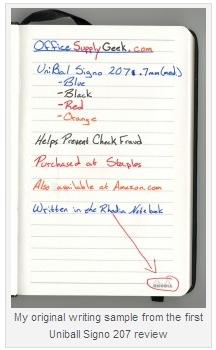
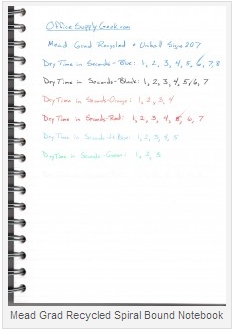
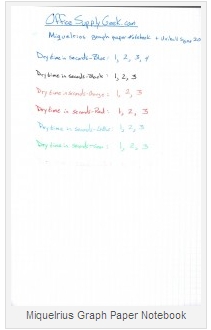
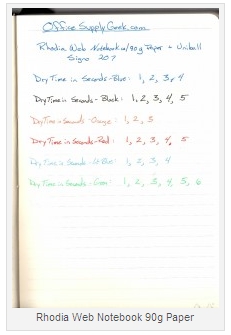
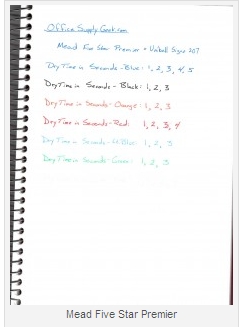
Recently I had a comment on my first Uniball Signo 207 review regarding the drying time for this ink on different papers. When I went back and looked at the review, I realized that I never did any kind of test to see how quickly these pens dry. So Luis, here is an update to take a look at the Signo 207 on some different paper.
Now the paper that Luis specifically asked about was the Mead Reinforced Filler Paper, which he used and had a terrible time with the Signo 207 ink smearing on it. Since I didn’t have that exact paper, I thought I’d start out by looking at some of the other Mead products that I had on hand to see how the Uniball Signo ink handled on those. First up was the Mead Grad Recycled Spiral Bound Notebook:
When I did the first few tests on this paper, I immediately saw what Luis was talking about with the dry time here. Not to say that this paper is exactly the same as the paper he was using, but there were some serious issues with how long it took the ink to dry on this paper. Having seen this extreme example, I was sure that I would need to continue my testing on some other notebooks to see if the results were different on other paper. One thing to note on this and all of the samples is that there is actually a color tested that for whatever reason didn’t show up in the scans, which was the pink ink. It’s the last writing sample on each page, so its hard to notice it is even not showing up.
Next I thought I’d try the Miquelrius Graph Paper Notebook because I always felt like the paper was good with some of the more wet inks out there. As you can see from the scan below, this paper didn’t let me down anywhere near as much as the Mead Recycled notebook paper. There was a slight bit of smearing noticeable with the black, blue, and red ink, but not so much on the others. Overall, I think that all of these inks did pretty well in this notebook. Check it out for yourself:
Next up is one of my more frequently used papers, which is the paper found in my Levenger Circa Notebook. Since I use Levenger paper on a daily basis, I am pretty comfortable with knowing what to expect from it, and I have not had much of a problem with any inks that I’ve used on it. To my surprise, the Signo ink showed a little more smudging than I would have expected on this paper. Most of the colors showed a bit of smudging after a few seconds, but none were what I would consider really bad or streaky.
The one paper that I was probably the most anxious to try this test on was the 90g paper in my Rhodia Web Notebook. This is by far my most favorite paper to write on because it is so smooth, and has almost zero feathering, bleed through, or show through with any ink, however it does tend to take inks a little longer to dry on this paper. The inks took a few seconds to dry on this paper as you can see in the scan below, and again, it looks like the blue and black color inks were probably the worst performing.
The last paper I tried the writing samples on was another selection from Mead. I figured that since their paper was the paper that initiated the whole conversation, I should throw one more variation of their product into the mix. This is the paper found in their Mead Five Star Primer coil bound notebook. Surprisingly enough, the paper in this Mead notebook turned out to be one of the best of the group to go along with the Uniball Signo 207 ink. Even the blue, black, and red inks that smudged noticeably on the other papers performed really well with minimal smudging, check out the writing sample below.
Overall I would say that the Mead Five Star Primer and the Miquelrius were the top two notebooks to use with this ink, while the Mead Grad Recycled was probably the worst, and the Levenger and Rhodia notebooks fell towards the middle of the pack. Obviously there are plenty of other papers out there that could have been tested, but I didn’t want this to be the War and Peace of reviews, so I had to stop somewhere.
Some other factors to take into consideration are the pressure you exert when you write on the paper, a heavier hand that puts more ink on the page is likely to take longer to dry than with someone who is a lighter writer. Also, the dry time is obviously going to be a bigger issue for someone who writes left-handed since they will be dragging their hand across the freshly written ink before it really has a chance to dry. The other thing to think about with these pens are that one of the key characteristics about them is that they were designed to be highly resistant to forging and fraud, so the ink is a little different from that of your standard pen.





